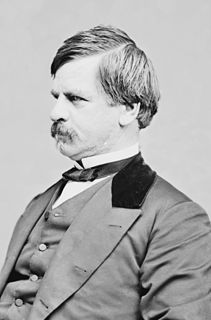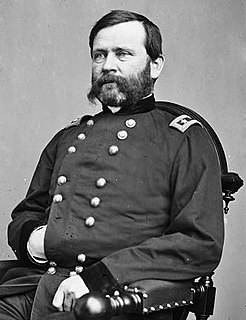
The Siege of Port Hudson, Louisiana, was the final engagement in the Union campaign to recapture the Mississippi River in the American Civil War.

The Bayou Teche is a 125-mile-long (201 km) waterway of great cultural significance in south central Louisiana in the United States. Bayou Teche was the Mississippi River's main course when it developed a delta about 2,800 to 4,500 years ago. Through a natural process known as deltaic switching, the river's deposits of silt and sediment cause the Mississippi to change its course every thousand years or so.

The Vicksburg Campaign was a series of maneuvers and battles in the Western Theater of the American Civil War directed against Vicksburg, Mississippi, a fortress city that dominated the last Confederate-controlled section of the Mississippi River. The Union Army of the Tennessee under Maj. Gen. Ulysses S. Grant gained control of the river by capturing this stronghold and defeating Lt. Gen. John C. Pemberton's forces stationed there.
XIX Corps was a corps of the Union Army during the American Civil War. It spent most of its service in Louisiana and the Gulf, though several units fought in Virginia's Shenandoah Valley.

Richard "Dick" Taylor was an American planter, politician, military historian, and Confederate general. Following the outbreak of the American Civil War, Taylor joined the Confederate States Army, serving first as a brigade commander in Virginia, and later as an army commander in the Trans-Mississippi Theater. Taylor commanded the District of West Louisiana and was responsible for successfully opposing United States troops invading upper northwest Louisiana during the Red River Campaign of 1864. He was the only son of Zachary Taylor, the 12th President of the United States.

The Battle of Milliken's Bend, fought June 7, 1863, was part of the Vicksburg Campaign of the American Civil War. Confederate Lt. Gen. John C. Pemberton and his army were besieged in Vicksburg, Mississippi, by Union commander Maj. Gen. Ulysses S. Grant and the Army of the Tennessee.

The Red River Campaign or Red River Expedition comprised a series of battles fought along the Red River in Louisiana during the American Civil War from March 10 to May 22, 1864. The campaign was a Union initiative, fought between approximately 30,000 Union troops under the command of Major General Nathaniel P. Banks, and Confederate troops under the command of Lieutenant General Richard Taylor, whose strength varied from 6,000 to 15,000.
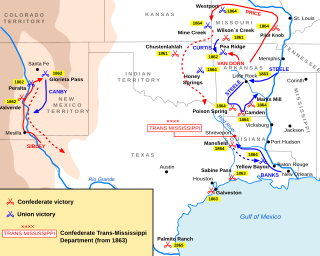
The Trans-Mississippi Theater of the American Civil War consists of the major military operations west of the Mississippi River. The area is often thought of as excluding the states and territories bordering the Pacific Ocean, which formed the Pacific Coast Theater of the American Civil War (1861-1865).
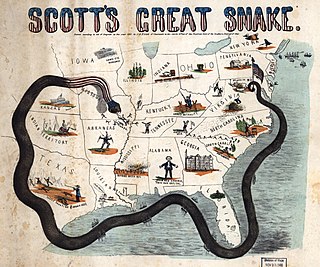
The Lower Seaboard Theater of the American Civil War encompassed major military and naval operations that occurred near the coastal areas of the Southeastern United States: in Alabama, Florida, Louisiana, Mississippi, South Carolina, and Texas) as well as southern part of the Mississippi River.
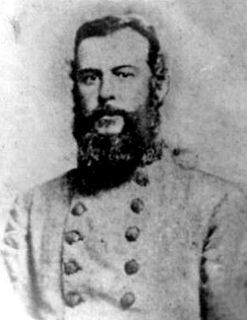
Jean-Jacques-Alfred-Alexandre "Alfred" Mouton was a Confederate general in the American Civil War. Although trained at West Point, he soon resigned his commission to become a civil engineer and then a sugarcane grower, while also serving as a brigadier general in the Louisiana State Militia.

Thomas Green was an American soldier and lawyer, who took part in the Texan Revolution of 1835–36, serving under Sam Houston, who rewarded him with a land grant. Green was clerk of the Texas Supreme Court until the outbreak of the Civil War, when he became a Confederate cavalry leader. After winning several victories, including the Battle of Valverde and the recapture of Galveston, he was promoted brigadier and assigned command of the cavalry division of the Trans-Mississippi Department. In the Red River Campaign, he was mortally wounded while charging a fleet of Federal gunboats. The Union naval commander David Dixon Porter paid tribute to Green as a serious loss to the Confederacy.
The Battle of Fort Bisland was fought in the American Civil War between Union Major General Nathaniel P. Banks against Confederate Major General Richard Taylor during Banks' operations against the Bayou Teche region in southern Louisiana.

The Battle of Irish Bend, also known as Nerson’s Woods or Franklin, was fought between Union Major General Nathaniel Prentice Banks against Confederate Major General Richard Taylor during Banks’s operations against the Bayou Teche region near Franklin, the seat of St. Mary Parish in southern Louisiana.
The Battle of Vermillion Bayou or Battle of Pinhook Bridge was fought on April 17, 1863, the third battle in a series of running battles between Union Major General Nathaniel Prentice Banks and Confederate Major General Richard Taylor. The battle was fought after both the Battle of Fort Bisland and the Battle of Irish Bend. On October 9, 1863 a skirmish with Confederate & Federal cavalry occurred at the same location.

Antebellum Louisiana was a slave state, where enslaved African Americans had comprised the majority of the population during the eighteenth century French and Spanish colonial period. By the time the United States acquired the territory (1803) and Louisiana became a state (1812), the institution of slavery was entrenched. By 1860, 47% of the state's population were enslaved, though the state also had one of the largest free black populations in the United States. Much of the white population, particularly in the cities, supported southern states' rights and slavery, while pockets of support for the U.S. and its government existed in the more rural areas.

The Battle of Fort De Russy, Louisiana, was the first engagement in the Red River Campaign of March–May 1864 in the American Civil War.

The Battle of Kock’s Plantation was a battle fought July 12–13, 1863, in Ascension Parish, Louisiana, during the American Civil War. It was part of a campaign entitled "Taylor's Operations in West Louisiana (1863)." The Confederate States Army victory left them in control of much of the interior of the Acadiana region.

The Port Hudson State Historic Site is located on the Mississippi River north of Baton Rouge in East Feliciana Parish, Louisiana, just outside the limits of Port Hudson and in the vicinity of Jackson. The site preserves a portion of the fortifications and battle area of the longest siege in American history, during the American Civil War from May 23 through July 9, 1863. The state of Louisiana maintains the site, which includes a museum about the siege, artillery displays, redoubts, and interpretive plaques. Living history re-enactments are held each year. It was designated a National Historic Landmark in 1974, significant as the first place where African-American military units fought for the Union Army under African-American field leadership.
Company A, Arizona Rangers was one of the Confederate military units raised in the Confederate Arizona Territory.

1st Regiment Indiana Heavy Artillery was a heavy artillery regiment that served in the Union Army during the American Civil War. It was nicknamed the "Jackass Regiment". Before being converted into an artillery unit in 1863 it served as the 21st Regiment, Indiana Volunteer Infantry.



